The decision of the Kerala State Government to devolve 35-40% of the Ninth five year plan outlay, for projects and programmes to be implemented by local self governments, posed severe challenges to systems for plan monitoring and for reporting of plan information in the state, The Information Kerala Mission (IKM), entrusted with the task of computerising local bodies in the state developed a web based tool ‘Sulekha’ to handle the issues in plan project monitoring, data acquisition and consolidation. The application has been tried out in five select locations. The paper examines in detail the salient features of the application and the issues arising out of its field level implementation.
Introduction
Following the decision of the government to devolve a sizeable chunk of the states plan outlay to the local bodies the government initiated a mass movement, popularly known as People’s campaign for decentralised planning to empower local self governments, and to prepare plans in a transparent and participatory manner. [Isaac, et. al (2000)]. The annual plans of local bodies involved preparation of project documents which were themselves visualised as participative local interventions to solve issues of public interest. These project documents were generated through structured interactions of the panchayat functionaries, functionaries in line departments, local development activists and beneficiaries. The documents were highly local specific and standardisation of objectives, achievements and targets was extremely difficult since this would infringe upon the creativity of local problem solving.
The project preparation was initiated through an intense training programme of the functionaries concerned. A variety of institutional and cultural changes were attempted in the project formulation and implementation. The vibrant environment of intense campaign activity, aimed at facilitating problem identification and problem solving, learning and un-learning, and system reengineering resulted in a state of flux where every thing was so dynamic. To devise a reporting system in such metamorphic and mutating environment was demanding and this was precisely the challenge of the Sulekha design. [Unnikrishnan, P.V.]
A system for plan monitoring for local bodies should facilitate
- A mechanism for data acquisition and local reporting which could facilitate strengthening the project management process locally.
- A mechanism for aggregation of the local body data at the various tiers which could facilitate vertical integration of local body plans.
- A mechanism for integrating the reporting system with the system of performance audit and plan evaluation studies, in order to provide checks and balances, and to evolve guidelines for plan expenditure, and also to facilitate changes in the macro policy framework, for taking advantage of the initiatives for economic development and social justice, at the local level.
A network architecture suitable for this approach was designed. (See figure 1). The option of linking the institutions transferred to the local bodies, which are also the implementing offices of the peoples’ plan themselves, and linking the Grama panchayats over dial up to blocks shall be taken up only in the phase 2. During phase 3 the state information network synthesises with the state information Infrastructure.
Fig 1. Network Connections in IKM an evolutionary perspective.
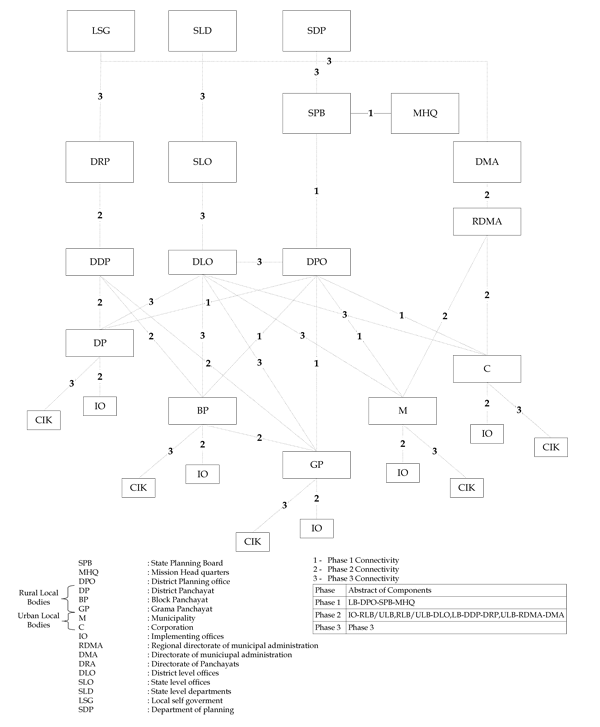
Looking into the broad requirements of application software development for the local bodies, arrived at based on a detailed system study taken by IKM, which also incorporates recommendations of the committee on decentralisation of powers, a technology choice was also arrived at. The salient features of the technology choice shall be as shown in Table 1.
Table 1. Technology choice for IKM
| 1. | Hardware (Client and Server) | Intels’ Pentium based system |
| 2. | Operating System | Client : Microsoft’s Window NT Work Station 4.0 Server : Microsoft’s Windows NT Server 4.0/ Windows 2000 Server |
| 3. | Development Tool | Microsoft’s Visual Basic 6.0 and ASP for Web applications. |
| 4. | Database Server | Microsoft SQL Server 7.0/SQL Server 2000 |
| 5. | Web server | Microsoft’s Internet Information Server 4.0/Internet Information Server 5.0 |
The design of Sulekha shall fit in with the network architecture and technology choice as outlined above.
The project management reporting tool ideally, should have seamlessly integrated with day to day accounting and overall financial management, right from the beginning, for reasons of better financial control. This should be so primarily because in all local bodies, the plan resources accounts for more than 40% of the total budget and further since accounting of the projects in the new local body context would have necessitated umpteen project cash books and ledgers. [Government of Kerala (2000)] However, it was decided to defer the integration of the plan reporting system with the local body accounting and financial management system to the next phase since the revised budget manual and the revised accounts manual for local bodies could not be finalised immediately.
Methods and Materials
Sulekha captures extensive project information which has been classified and categorised for the purpose of validation and standardisation for meaningful consolidation. The coverage of project attributes is shown in Annexure 1.
Sulekha consists of three application modules
- Sulekha (local body)
- Sulekha (District Planning Office)
- Sulekha (State Planning Board) The features are shown in table 2.
Table 2. Main features of Sulekha
| Sl. No. | Type |
Main features |
|||
|
Data Aquisition |
Data Validation |
Report generation |
Data transmission |
||
| 1 | Sulekha (local body) | LB data entry, verification and approval | Standardisationbased on masters and simple numerical and logical checks | Local level reports and process audit reports, reports on local economy | LB to DPO reporting and down loading of masters from DPO |
| 2 | Sulekha(District Planning Office) | NIL | NIL | Consolidated district level reports with drill down, archive of model projects etc | Supervision and control of transmission. Uploading data to the state and downloading masters from the state |
| 3 | State Planning Board | Master table entries and updation | Consolidated state level reports with drill down | Linkages to DPO for upward data transmission and report transmission of masters | |
Since the plan formulation and implementation guidelines were continuously evolving, it was extremely difficult to design a system for data acquisition, validation, consolidation and reporting. It was therefore decided to design the application based on the most stringent data requirements based on a simulated ideal process framework with provision for auditing process discrepancies and reporting them. The conceptual module of PMS takes the form of figure 1. As could be seen from the figure the four stages in the lifecycle of a project are plan formulation, evaluation, appraisal and implementation. The monitoring systems shall acquire information recorded in a project status registry as shown in the figure. The elements of the project registry and the state transition of the registry is shown in table 3.
Fig 2: Stages in the life cycle of PMS Module
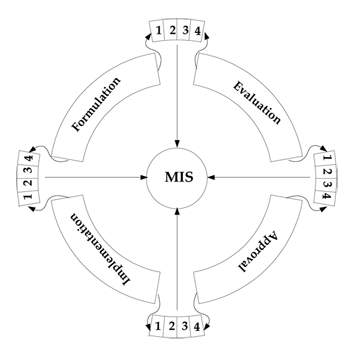
Table 3. Elements of project registry and state transition of the registry
|
Registry Cell |
Registry Components | State Transition levels |
| 1 | Physical targets | Projected at formulation finalised at formulation Projected at evaluation finalised at evaluation Projected at approval finalised at approval |
| 2 | Time Schedule | |
| 3 | Organisational Beneficiaries Institutional linkages Products, Processes and technology | |
| 4 | Resources
|
Finalised at implementation |
Communication between the various Sulekha modules, as outlined in Table 3 is achieved using the data transmission services of MS SQL 7.0. The application has been optimised to reduce common location overheads by using incremental transfer without compromising data integrity and synchronisation. The application uses a four-tier architecture based on active server pages technology – the presentation tier, the middle tiers and the data base tier (See figure 3). The presentation tier consists of the browser and report viewer AciveX component which handles user interaction and client side validations. The linkage of the presentation tier with the web server uses the ASP 5 object model with five intrinsic. The client side validation is taken care of by client side scripting in Visual Basic and Visual Java. Remote scripting is used for interactive downloading of masters relating to micro sector classification of projects.
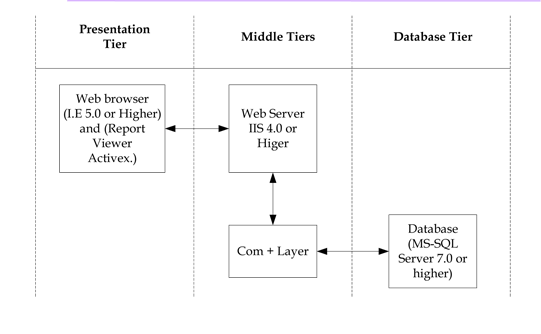
Fig 3. Architecture of Sulekha
To evolve a physical target scheme for the entire gamut of projects is very tedious. But leaving it adhoc would make aggregation of implementation performance impossible. A scheme of 736 physical targets with additional attribute information suitable for a second level classification of targets was evolved. Listing of such an extensive library of targets cannot facilitate their use. The only possibility to ensure their use is to categorise the targets into groups which could be remembered and applied conveniently based on the context. Two models one for productive sector projects and for infrastructure and service sector projects was formulated as shown below. Using the models all the physical targets and their attributes for a productive sector project could be classified into four classes viz
- Inputs
- Outputs
- Credit and market linkages
- Mechanisms and institutions for quality control
For infrastructure and service sector projects the targets and attributes could be classified as
- Evaluation mechanism related
- Infrastructure improvement related
- Delivery of services related
- Institutional linkages for improvement of quality of service
- Please see figures 3 and 4.
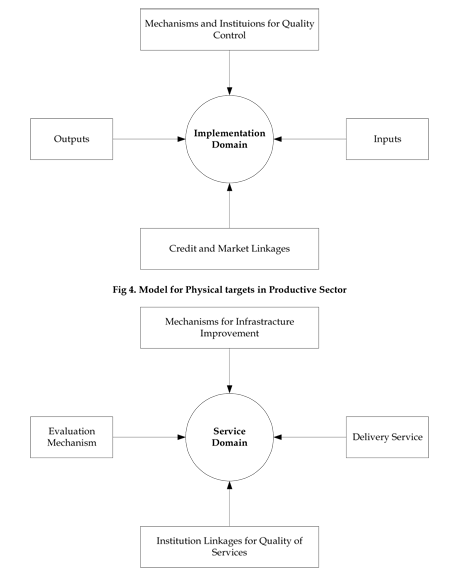
The methodology of software development of Sulekha, followed the human centred participatory software development strategy evolved for IKM (Unnikrishnan.P.V., (2001)]. A number of persons involved in the peoples’ plan campaign at the political, bureaucratic and activist level interacted in formulating the concepts. Prototypes of the reporting tool where developed to faciliate further interaction. The life cycle of the product with major changes has been shown in table 5.
Table 5. Life Cycle of Sulekha
| PMS 1.0 |
|
| PMS 2.0 |
|
| PMS 3.0 |
|
| PMS 4.0 |
|
| SULEKHA |
|
The interactions at the conceptual level and in vetting the prototype where no doubt valid, but very few of the people who participated had good understanding of the variations in project documentation practice across the state and quality of data being documented. Very little data was available at the State Level, and whatever data available was collected through specially designed data collection prepared by the planning commission. After making evaluation of the data made available by local bodies through these forms. IKM designed an improved proforma which was used for data collection from the various implementing offices and panchayts in Trivandrum District. It was based on these inputs that the Sulekha attribute definition covered in the scheme of masters as shown in Annexure 1 was arrived at.
Results and Discussion
The Sulekha application was subsequently implemented in five grama panchayats of Trivandrum District viz. Ambbori, Kattakada, Madavoor, Vellanad and Vilavoorkal. The implementation brought out strengths of the design strategy resorted to by Information Kerala Mission. Significant improvement in coverage of data could be achieved reflecting the effectiveness of the design. See table 6 below. The data collected and entered using the application, also showed higher levels of consistency.
Table 6. Improvement achieved through the application.
| S.No | Type of attribute | % Improvement |
| 1 | Plan formulation | 30% |
| 2 | Plan appraisal | 85% |
| 3 | Plan approval | 90% |
| 4 | Plan implementation | 50% |
Conclusion
The design of ‘Sulekha’ throws light into design strategies that could be used in systems with high level of transience. Integration of the accounting package ‘Sankhya’ the decision support system ‘Sakarma’ and the workflow system ‘Soochika’ with ‘Sulekha’ would go a long way in strengthening the system of project management further.
References
- Government of Kerala (1999), “The Final Report of the Committee on Decentralisation of Powers”, Chaired by Dr. Sutyabrato Sen, submitted to the Government of Kerala on 23 December 1997.
- Government of Kerala (2000), “The report of the State Finance Commission”, chaired by Dr. Prabhat Patnaik submitted to the government of Kerala in June, 2001.
- Isaac, Thomas and Franke, Richard (2000), “Local democracy and development”, peoples campaign for decentralised planning in Kerala, Left Word, New Delhi.
- Unnikrishnan P.V., (1999), “Strengthening plan monitoring systems (Malayalam)”, volume 3, Issue 12-13, Marxist Samavadam, April- September, 1999
- Unnikrishnan.P.V. (2001), “Information Kerala Mission: Unfolding of a silent revolution”, Information Kerala Mission, Trivandrum
Annexure 1. Coverage of project attributes
| Type of the Attribute | Name of the Attribute | Mandatorily Required or Not |
Whether Quantified against Masters or Not |
Mode of Entry |
| Approval | Amount approved by BLEC | Yes | No | DET |
| Date of approval by LB,DPC,BLEC | ||||
| Date of Approval of renewal of Project by LB, DPC, BLEC | ||||
| Date of temporary Approval | ||||
| Disputed Project | Yes | SCB | ||
| Reference Number of approval by LB, DPC, BLEC | No | DET | ||
| Reference Number of approval of renewal of Project by BLEC | ||||
| Reference Number of approval of renewal of Project by DPC | ||||
| Reference Number of approval of renewal of Project by LB | ||||
| Reference Number of Temporary approval | ||||
| Requirement of Detailed Project report | SCB | |||
| Financial Estimate |
Beneficiary Contribution (Current Year), (Previous Year) | No | DET | |
| Beneficiary Contribution- Direct (Current Year), (Previous Year) | ||||
| CSS Share (Current Year), (Previous Year) | ||||
| Grant in Aid (Current Year),(Previous Year) | ||||
| Loan from Cooperatives (Current Year), (Previous Year) | ||||
| Loan from financial institutions(Current Year), (Previous Year) | ||||
| Others (Current Year), (Previous Year) | ||||
| Own Fund (Current Year), (Previous Year) | ||||
| SSS Share (Current Year), (Previous Year) | ||||
| Total Project Estimate (Current Year),(Previous Year) | Yes | |||
| General | Centrally Sponsored Scheme | No | Yes | CS |
| Micro Sector | Yes | |||
| Micro Sector Code | AG | |||
| Project Category | CS | |||
| Project Name | No | DET | ||
| Project Serial Number | ||||
| Project Serial Number (Last Year) | No | CS | ||
| Project Type | Yes | Yes | ||
| Sector | ||||
| Sector Type | ||||
| State Sponsored Scheme | No | |||
| Sub Sector | Yes | |||
| Women Development Project | SCB | |||
| Implementation | Approved Implementing Agency | No | CS | |
| Date of commencement of the Project | Yes | No | DET | |
| Date of completion of Project | ||||
| Implementing Officer | Yes | CS | ||
| Mode of Implementation | ||||
| Other Implementing Agency | No | |||
| Project discarded | Yes | No | SCB | |
| Scheduled End Month & Year | DET | |||
| Scheduled Start Month & Year | ||||
| Physical Targets | Physical Target and attribute | Yes | AG | |
| Physical Target Description | No | DET | ||
| Physical Target Quantity Targeted | ||||
| Physical target Unit | Yes | AG |
- DET - Data Entry in Text Box
- SCB - Selection in Check Box
- AG - Auto Generated
- CS - Selection in Combo Box
